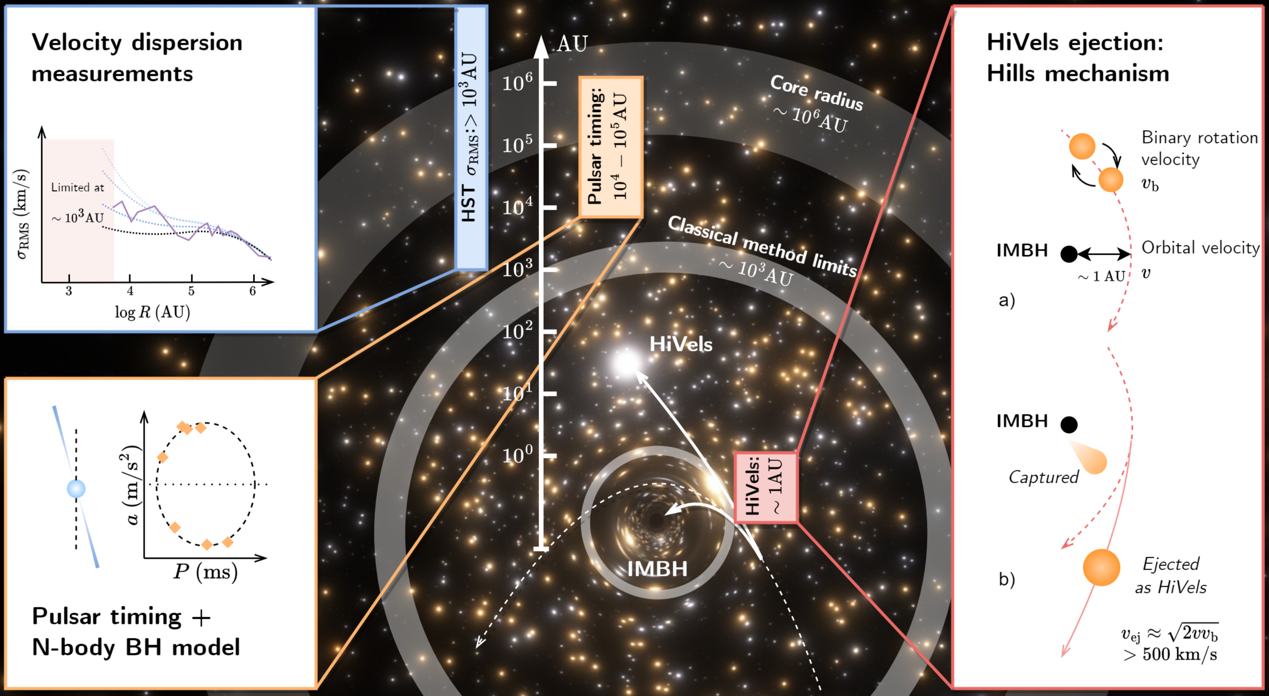Recently, researchers from the University of Chinese Academy of Sciences, National Astronomical Observatories, Yunnan Observatories, Peking University, Beijing NormalUniversityproposed that searching for high-velocity stars ejected from globular clusters due to the gravitational slingshot effect (Hills mechanism) could provide compelling evidence for the long-sought intermediate-mass black holes (IMBHs). By conducting detailed orbital backtracking of nearly a thousand high-velocity stars identified in Gaia and LAMOST data, along with over a hundred globular clusters in the Milky Way, the research team discovered that the high-velocity star J0731+3717 was ejected from the globular cluster M15 approximately 20 million years ago at an extreme velocity of nearly 550 km/s, with a confidence level of 5.4σ. This exceptionally high ejection speed is most likely caused by the Hills mechanism, suggesting the possible presence of an intermediate-mass black hole at the center of M15. This study has been published as the cover article in the February 2025 issue of National Science Review (NSR), titled "A high-velocity star recently ejected by an intermediate-mass black hole in M15." Associate Professor Yang Huang from the University of Chinese Academy of Sciences is the co-first author and corresponding author of the paper. Dr. Qingzheng Li (a graduate student of Yunnan Astronomical Observatory) is also a co-first author. Researcher Jifeng Liu from the National Astronomical Observatories, Researcher Xiaobo Dong from Yunnan Astronomical Observatory, and Professor Huawei Zhang from Peking University are co-corresponding authors.
Stellar-mass black holes—formed from the collapse of massive stars, such as Cygnus X-1 (which famously led Hawking to concede a bet)— and supermassive black holes—residing at the centers of large galaxies, like Sagittarius A* in the Milky Way—are well-established.
However, black holes with masses in between, known as intermediate-mass black holes (IMBHs), are often considered to be a gap and a crucial missing link in the evolution from seed black holes into supermassive ones. To date, only a few controversial candidates have been found, leaving their existence an open question in astrophysics.
Globular clusters are considered ideal hiding places for IMBHs due to their extremely high stellar densities. Within these dense environments, IMBHs could form through two primary mechanisms: (1) Rapid formation, in which repeated stellar mergers produce a (super)massive star that eventually collapses into a black hole, and (2) Slow formation, where successive mergers of stellar-mass black holes over time gradually build up to an IMBH.
As early as the early 2000s, astronomers used the Hubble Space Telescope (HST) to observe M15 with its ultra-high spatial resolution Space Telescope Imaging Spectrograph (STIS) and derived its line-of-sight velocity dispersion curve. Using N-body numerical simulations, researchers suggested that M15 might host an IMBH with a mass between 1,700 and 3,200 solar masses. However, this conclusion faced skepticism. The HST velocity dispersion curve was measured at a projected radius of 0.5 arcseconds from the cluster center (about 5,000 AU at the distance of M15), a region where thousands of compact stars might exist in addition to a black hole. Follow-up studies using pulsar timing also hinted at the presence of IMBHs in globular clusters, but since these pulsars were located even farther from the cluster centers, they could not rule out the possibility of a dense cluster of stellar remnants.

Figure 1: Comparison of traditional velocity dispersion and pulsar timing methods (left) versus the HiVel ejection from globular clusters method (right) in the search for IMBHs.
Thus, finding an effective method to detect IMBHs as close as possible to the centers of globular clusters has become the final missing piece of evidence (see Figure 1, which illustrates the measurement principles).
“To overcome this challenge, we propose a systematic search for hypervelocity/high-velocity stars accelerated by the gravitational slingshot effect (Hills mechanism), where a cluster hosting an IMBH can disrupt a tight binary system orbiting nearby, concentrating the black hole's mass into a much smaller region,” says Jifeng Liu, Director of National Astronomical Observatories, Chinese Academy of Sciences and lead author of the study.
"By tracing nearly a thousand high-velocity stars (with total velocities exceeding 400 km/s) and over a hundred globular clusters using data from Gaia, LAMOST, SDSS, and other spectroscopic surveys, we have discovered that J0731+3717 was ejected from M15—marking the first time a high-velocity star originating from a globular cluster has been identified—at nearly 550 km/s approximately 20 million years ago," says Yang Huang, researcher at School of Astronomy and Space Science, University of the Chinese Academy of Sciences and first-author of the study.
Remarkably, J0731+3717 shares striking similarities with M15 in both chemical composition and age.
To eject a star at such an extreme velocity from a globular cluster, a tight binary system must have passed within one astronomical unit (AU) of an IMBH with a mass of several thousand solar masses.
“The strong tidal forces of the IMBH would have torn the binary apart—capturing one star while flinging the other away at high speed,” explains Xiaobo Dong, researcher at Yunnan Observatories, Chinese Academy of Sciences and lead author of the study.
This unique discovery confines a few thousand solar masses within just a few AU, effectively ruling out the possibility that the mass is composed of thousands of neutron stars or stellar-mass black holes. The only plausible explanation is a single black hole, thereby confirming the existence of an IMBH in M15. By identifying the first-ever high-velocity star ejected by an IMBH in a globular cluster, this study completes the final missing link in the evidence chain for IMBHs.
“With the continuous accumulation of data from Gaia and large-scale spectroscopic surveys such as LAMOST, we expect to discover several more stars like J0731+3717 in the near future, which will greatly advance our understanding of the elusive IMBHs,” says Huawei Zhang, Director of Department of Astronomy, School of Physics, Peking University and lead author of the study.

Figure 2: Artist's illustration of an IMBH ejecting a high-velocity star from a globular cluster.
Paper link: https://academic.oup.com/nsr/article/12/2/nwae347/7810597